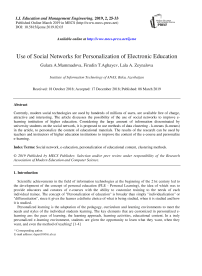Use of social networks for personalization of electronic education
Автор: Gulara A.Mammadova, Firudin T.Aghayev, Lala A. Zeynalova
Журнал: International Journal of Education and Management Engineering @ijeme
Статья в выпуске: 2 vol.9, 2019 года.
Бесплатный доступ
Currently, modern social technologies are used by hundreds of millions of users, are available free of charge, attractive and interesting. The article discusses the possibility of the use of social networks to improve e-learning institution of higher education. Considering the large amount of information disseminated by university students on the social network, it is proposed to use methods of data clustering - k-means (k-means) in the article, to personalize the content of educational materials. The results of the research can be used by teachers and instructors of higher education institutions to improve the content of the e-course and personalize e-learning.
Social network, e-education, personalization of educational content, clustering methods
Короткий адрес: https://sciup.org/15015798
IDR: 15015798 | DOI: 10.5815/ijeme.2019.02.03
Список литературы Use of social networks for personalization of electronic education
- Starodubtsev VA, Personalization of the virtual educational environment, Pedagogical Education in Russia. 2015. № 7, p. 24-29.
- M. Johnson. “Personalised Learning”. New Economy. vol II, no 4, 2004. pp. 224-228.
- Sandler, S. People v. ‘personalization’: Retaining the human element in the high-tech era of education. Education Week, 2012, 31(22), pp.20–22.
- Baker, R .S. J. D., & Yacef, K. The state of educational data mining in 2009: A review and future visions. Journal of Educational Data Mining. 2009, 1(1), 3–17.
- M. Harmelen, Personal Learning Environments, Proceedings of the Sixth IEEE International Conference on Advanced Learning Technologies, USA, pp.815-816.
- Erdos P., Renyi A. On the evolution of random graphs // Publication of Mathematics Institute Hungary Academy of the Science. – 1960. V. 5. – P. 17–61.
- Wellman, B. The community question. American Journal of Sociology, 1979, 84, p. 1201-1207.
- Bennett S., Bishop A., Dalgarno B., Waycott J., Kennedy G., Implementing Web 2.0 technologies in higher education: A collective case study, Computers & Education, 2012, рр. 724-729.
- Pursel B. K., Xie H., Patterns and Pedagogy: Exploring Student Blog Use in Higher Education, Contemporary Educational Technology, 2014, 5(2), pp.96-109.
- Schroeder A., Minocha S., Schneider C., The strengths, weaknesses, opportunities and threats of using social software in higher and further education teaching and learning, Journal of Computer Assisted Learning, 2010, pp.159-174.
- Hosny M. I., Fatima Sh., Facebok in Education: Students, Teachers, and Library Perspectives, journal of Computing, volume 4, № 6, 2012, pp.78-86.
- McLoughlin C. E., Lee M., Personalised and self regulated learning in the Web 2.0: International exemplars of innovative pedagogy using social software, Australasian Journal of Educational Technology 26(1), March 2010, pp. 28-43.
- Allen M., An Education in Facebook, Digital Culture and Education, 4 (3), 2012, pp. 213-225.
- Terry Anderson* and Jon Dron Anderson, T., & Dron, J. (2017). Integrating learning management and social networking systems. Italian Journal of Educational Technology, 25(3), 5-19.
- Veeramanickam Murugappan. A Smart E-Learning System for Social Networking, International Journal of Electrical and Computer Engineering (IJECE) Vol. 4, No. 3, June 2014, pp. 447-455.
- https://cs.stanford.edu/people/jure/pubs/circles-nips12.pdf
- Tianyi Hao, Longbo Huang. A Social Interaction Activity based Time-Varying User Vectorization Method for Online Social Networks Proceedings. 28 International Joint Conference on Artificial Intelligence (IJCAI-18), 2018, pp. 3790-3796.
- Ribeiro F.M.S., Contributions of Online Social Networks for E-Learning (Dissertation), Department of Informatics University of Beira Interior, Portugal, 2010, p. 70 (On-line) https://ubibliorum.ubi.pt/bitstream/10400.6/3715/1/Contributions of Online Social Networks for E-Learning.pdf
- V.I. Nosov, Elements of graph theory, Novosibirsk: SSUTI, 2008, p. 107.
- Brandes, U., and Erlebach, T. Network analysis: methodological foundations. In Springer, Lecture notes in computer science, Springer, 2005. pp 471.
- Charu C. Aggarwal Social Network Data Analytics. Boston: Kluwer Academic Publisher, 2011. 520 p.
- Liben-Nowell, D., and Kleinberg, J. M. The link-prediction problem for social networks. In JASIST, 2007. 58(7): pp. 1019–1031.
- Batura T.V. Methods of analysis of computer social networks // Bulletin of Novosibirsk State University. Series: Information technology. 2012. Vol. 10, no. 4. pp. 13-28.
- Russell, M. A., Mining the Social Web, O’Reilly Media, 2011, p. 411.
- Bonatoa, A. & Hadib, N. & Hornc, P. & Prałatd, P. & Wange, C., Models of Online Social Networks. Internet Mathematics, 6(3), 2009, pp. 285-313.
- Medvedev, GA Theory of Probability and Mathematical Statistics for Economists; textbook and workshop for undergraduate and graduate students, Moscow: Publishing House Yurapt, 2016. - p. 284.
- Mishra, N. & Schreiber, R. & Stanton I. & Tarjan, R. E., Finding Strongly-Knit Clusters in Social Networks. Internet Mathematics, 5(1-2), 2008, pp.155-174.


